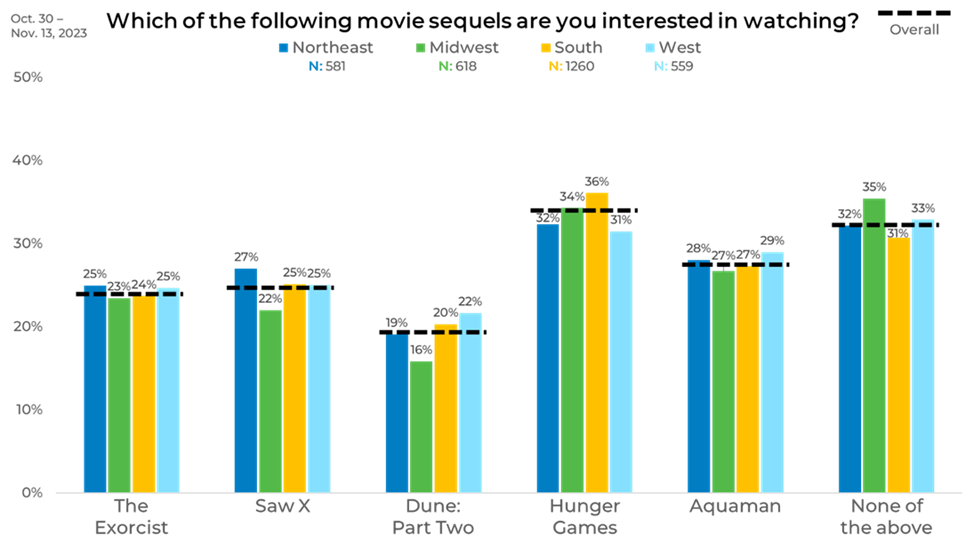
AI and Cinema Part 2: Can AI Predict the Next Blockbuster?
December 8, 2023
Intellicast S6E30: Continuing the AI Discussion
December 13, 2023Winter’s cinematic slate brings a flurry of highly anticipated movie sequels, each vying for the spotlight during this festive season. The Exorcist: Believer haunted theaters early on, setting a high bar for the follow-ups. Close on its heels, Saw X slashed its way into the scene in late September, extending the season’s chills. Looking ahead, Dune: Part Two is set to whisk us away to the dunes of Arrakis in 2024, while The Hunger Games: The Ballad of Songbirds & Snakes captured our attention this past Thanksgiving. With its upcoming December release, Aquaman and the Lost Kingdom will splash in the holiday movie pool. And yet, a segment of the audience is holding out for something beyond the established franchises, ready to be surprised by new tales.
In our latest round of research-on-research, we explored people’s preferences around the slate of movie sequels.
Overall, we found that people were looking forward most to the next installment of the Hunger Games franchise. A third of those polled are keen on seeing the survival games unfold again, showcasing the series’ solid and enduring appeal. Conversely, nearly the same amount opted for none of the above, indicating a prevailing interest in non-established franchises. This points to a potential market for new and original films or overall fatigue people have with sequels. Meanwhile, Dune: Part Two appears to face an uphill battle in capturing the same level of audience enthusiasm, trailing significantly with only 19% interest.

Gender
Our survey revealed some interesting differences in movie sequel preferences between genders. Men showed more interest across the board in the sequels, with the most significant gap being a 12% higher interest in Dune: Part Two than women. Women, contrastingly, were 9% more likely than men to opt out of all the sequel choices, indicating a preference to skip these particular films.

Age
The enthusiasm for upcoming movie sequels has much to do with your age. For those over 65, there’s not much hype – 62% aren’t looking forward to any of the movies mentioned, which starkly contrasts with just 17% of the 18-24 age group feeling the same way.
And Saw X? Only 4% of the 65+ crowd are into it, which is 15% lower than any other age group.
It looks like sequel interest hits a high note with the 25–34-year-olds – they’re the group with an above-average interest in all the movies listed. So, it seems like the silver screen has its sweet spot with the young adult crowd, and as folks age, their interest in sequels starts to cool off.

Income
Income plays a notable role in shaping movie sequel preferences. For Dune: Part Two and Hunger Games, there’s a clear trend: the higher the income, the higher the likelihood of wanting to watch these films. Those with incomes above $100,000 show a significant 13% and 12% greater interest in these movies, respectively, compared to those earning less than $20,000.
At the lower end of the income scale, under $20,000, there’s generally less enthusiasm for the movie lineup, except when it comes to Saw X, where this group stands out as the second most interested. Meanwhile, individuals earning between $40,000 and $59,999 exhibit the most interest in horror and thriller genres, leading the pack for The Exorcist and Saw X.

Political Affiliation
The results segmented by political affiliation show Democrats leading the interest in upcoming movie sequels. They’re 6% more likely to be interested in Saw X and 5% more likely to choose Aquaman than other political groups.

Ethnicity
Interest in the movie sequels varied notably across ethnicities. Hispanic/Latino viewers showed the most enthusiasm, leading in interest for each film and showing the slightest preference for none of the above. African Americans ranked as the second group most likely to catch The Exorcist, Saw X, and Aquaman.
Asians and South Asians displayed a strong inclination towards Dune and Hunger Games, positioning them as the second most interested group in these titles. Yet, they were less likely to show interest in The Exorcist or Saw X. On the other hand, Caucasian respondents showed less interest than other reported ethnic groups.

Region
When it comes to getting excited about movie sequels, it seems where you live might play a role in what you’re eager to watch. Interest in The Exorcist was pretty even across the board, with only a tiny 2% difference between regions. But for Saw X, folks in the Northeast are most likely to grab a ticket, showing 27% interest, which is a noticeable 5% higher than the Midwest, where excitement for this thriller is the lowest.
Dune: Part Two isn’t getting much Midwest love either—they’re 3% less interested than other regions and a full 6% behind the West, where anticipation is strongest. The Hunger Games is a different story in the South, where they’re 5% more into it than the fans out West. And if you’re in the Midwest, it seems there’s a good chance you’re skipping the sequels altogether, with 35% of folks there not keen on any of the movies, the highest of any region.

Panel
Next, the spotlight falls on the breakdown of results by panel. Panel D’s members are notably more enthusiastic about the Hunger Games sequel, with a 17% higher interest than their counterparts in Panel E. They lead the pack with a 12% greater interest than any other panel.
Shift the lens to Panel E, and the enthusiasm dims considerably. Here, the preference for none of the above outstrips Panel D by a significant 20%, the largest discrepancy noted. If Panel B were the chosen audience, one would predict a box office win for the likes of The Exorcist, Saw X, and Dune. In stark contrast, Panel E’s responses, where a notable 41% are indifferent to the sequels, could suggest a pivot towards fresher storylines or different genres altogether.

As you can see, attitudes and preferences can vary significantly across not only demographics but by panel. For example, if you were gauging interest in a Hunger Games sequel and only used Panel D, your results would be significantly higher than if you used Panel E. These variations reinforce the need to strategically blend sample in our online quantitative research. Understanding how panels differ and how that can impact results can help you conduct better research and ultimately make better decisions.
Learn more about panel differences in our annual report on the sample industry, The Sample Landscape: 2023 Edition.




